Business Proposal: Challenges of Managing Global Teams, IHRM Focus
VerifiedAdded on 2020/03/04
|14
|2611
|104
Report
AI Summary
This business proposal investigates the challenges of managing global teams, a crucial topic in today's interconnected business environment. It begins with an executive summary and introduction, followed by a detailed literature review defining global teams and exploring issues related to virtuality, cultural diversity, and the implications of International Human Resource Management (IHRM). The proposal examines mechanisms for managing virtuality (Transactive Memory System, psychologically safe communication climate, and trust) and cultural diversity (cultural intelligence, cultural agility, and global mindset). It identifies key challenges such as geographical separation, knowledge sharing, time management, and cultural differences. The proposal highlights a literature gap concerning the role of non-executive team members and proposes a hypothesis and research questions to address this gap. The methodology section outlines both qualitative and quantitative research approaches, including sampling, data collection methods (interviews and questionnaires), and data analysis processes. The proposal acknowledges research limitations and includes a detailed time schedule for project completion. The conclusion emphasizes the significance of the research and the importance of understanding the roles of all team members in managing the challenges of global teams. The report aims to contribute to the existing body of knowledge by focusing on the often-overlooked perspectives of non-executive staff.
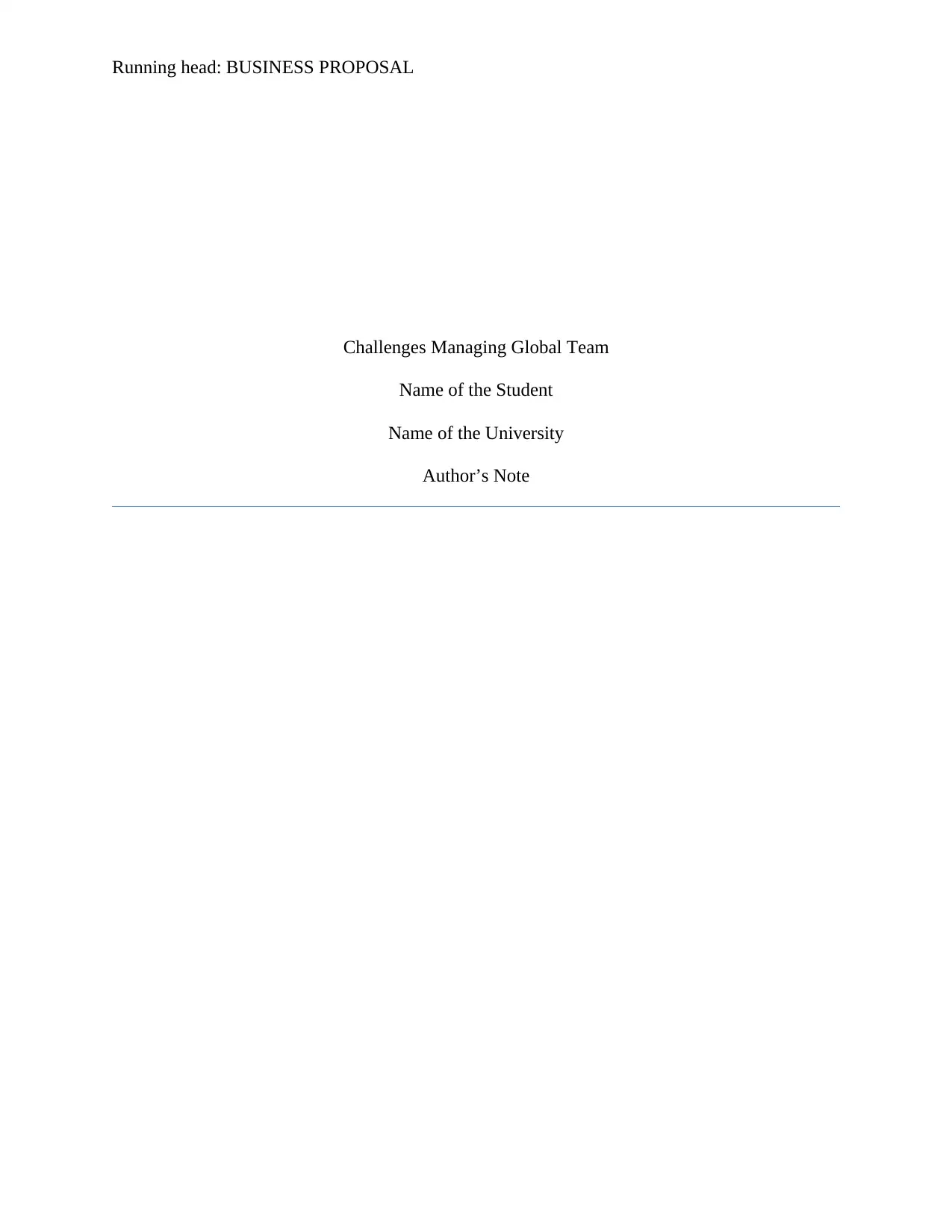
Running head: BUSINESS PROPOSAL
Challenges Managing Global Team
Name of the Student
Name of the University
Author’s Note
Challenges Managing Global Team
Name of the Student
Name of the University
Author’s Note
Paraphrase This Document
Need a fresh take? Get an instant paraphrase of this document with our AI Paraphraser
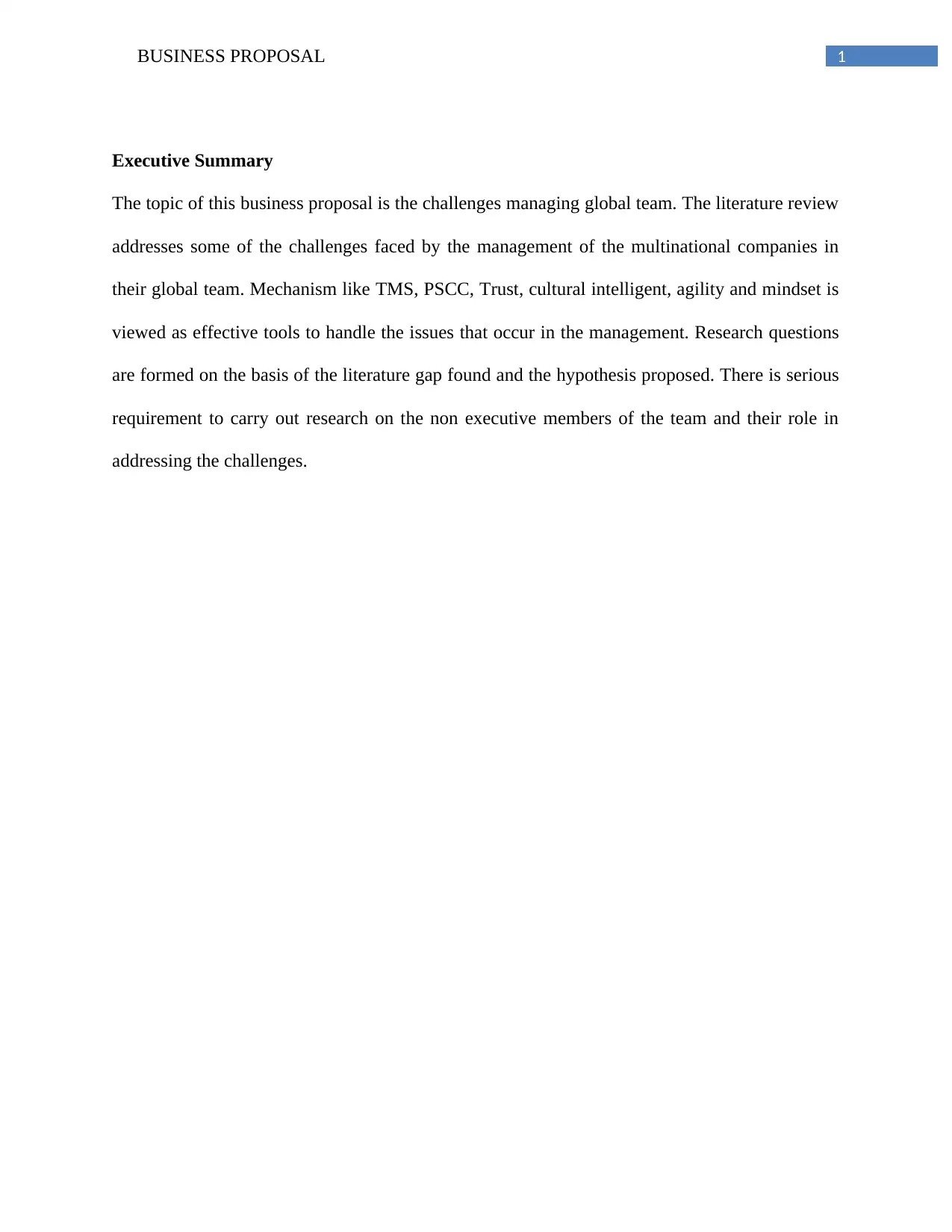
1BUSINESS PROPOSAL
Executive Summary
The topic of this business proposal is the challenges managing global team. The literature review
addresses some of the challenges faced by the management of the multinational companies in
their global team. Mechanism like TMS, PSCC, Trust, cultural intelligent, agility and mindset is
viewed as effective tools to handle the issues that occur in the management. Research questions
are formed on the basis of the literature gap found and the hypothesis proposed. There is serious
requirement to carry out research on the non executive members of the team and their role in
addressing the challenges.
Executive Summary
The topic of this business proposal is the challenges managing global team. The literature review
addresses some of the challenges faced by the management of the multinational companies in
their global team. Mechanism like TMS, PSCC, Trust, cultural intelligent, agility and mindset is
viewed as effective tools to handle the issues that occur in the management. Research questions
are formed on the basis of the literature gap found and the hypothesis proposed. There is serious
requirement to carry out research on the non executive members of the team and their role in
addressing the challenges.
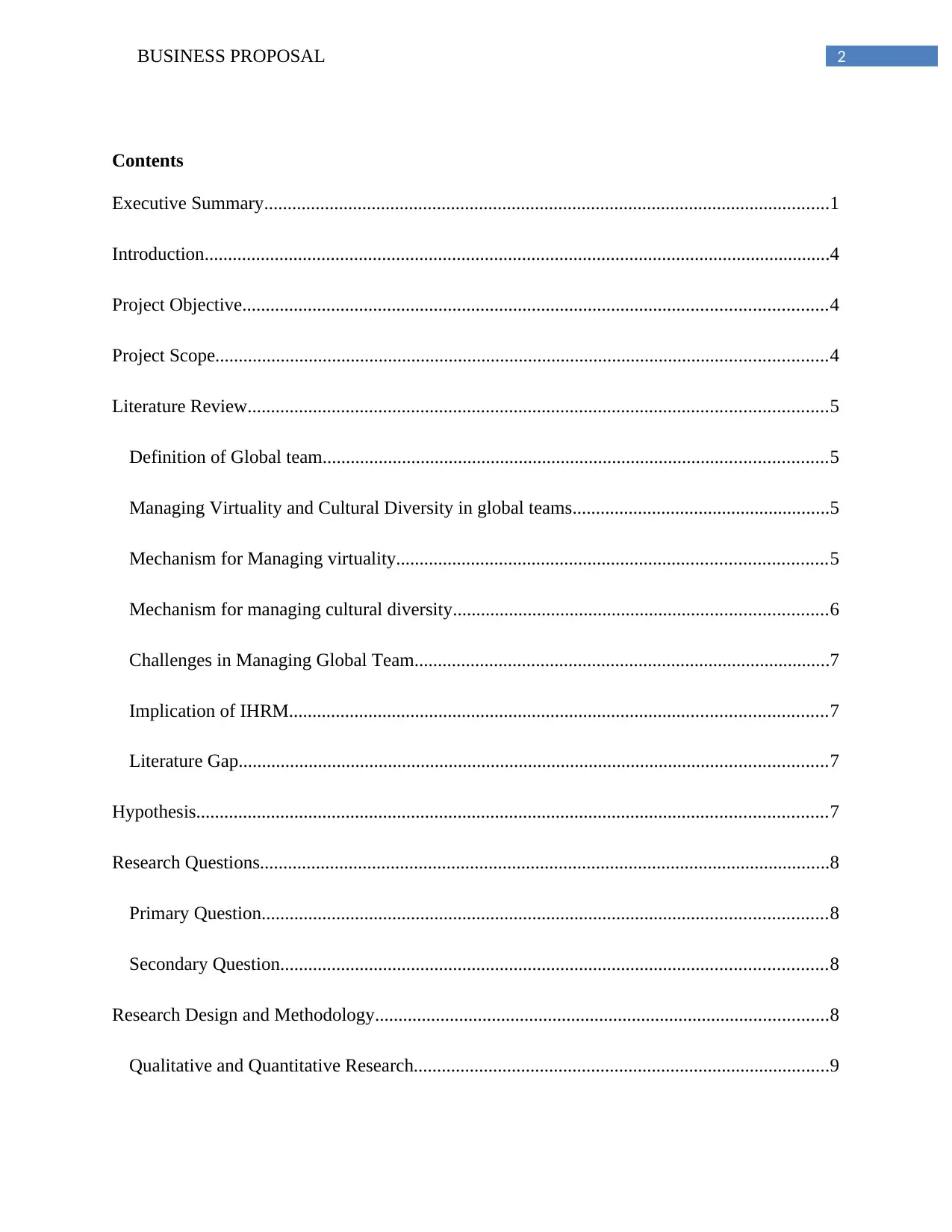
2BUSINESS PROPOSAL
Contents
Executive Summary.........................................................................................................................1
Introduction......................................................................................................................................4
Project Objective.............................................................................................................................4
Project Scope...................................................................................................................................4
Literature Review............................................................................................................................5
Definition of Global team............................................................................................................5
Managing Virtuality and Cultural Diversity in global teams.......................................................5
Mechanism for Managing virtuality............................................................................................5
Mechanism for managing cultural diversity................................................................................6
Challenges in Managing Global Team.........................................................................................7
Implication of IHRM...................................................................................................................7
Literature Gap..............................................................................................................................7
Hypothesis.......................................................................................................................................7
Research Questions..........................................................................................................................8
Primary Question.........................................................................................................................8
Secondary Question.....................................................................................................................8
Research Design and Methodology.................................................................................................8
Qualitative and Quantitative Research.........................................................................................9
Contents
Executive Summary.........................................................................................................................1
Introduction......................................................................................................................................4
Project Objective.............................................................................................................................4
Project Scope...................................................................................................................................4
Literature Review............................................................................................................................5
Definition of Global team............................................................................................................5
Managing Virtuality and Cultural Diversity in global teams.......................................................5
Mechanism for Managing virtuality............................................................................................5
Mechanism for managing cultural diversity................................................................................6
Challenges in Managing Global Team.........................................................................................7
Implication of IHRM...................................................................................................................7
Literature Gap..............................................................................................................................7
Hypothesis.......................................................................................................................................7
Research Questions..........................................................................................................................8
Primary Question.........................................................................................................................8
Secondary Question.....................................................................................................................8
Research Design and Methodology.................................................................................................8
Qualitative and Quantitative Research.........................................................................................9
⊘ This is a preview!⊘
Do you want full access?
Subscribe today to unlock all pages.

Trusted by 1+ million students worldwide
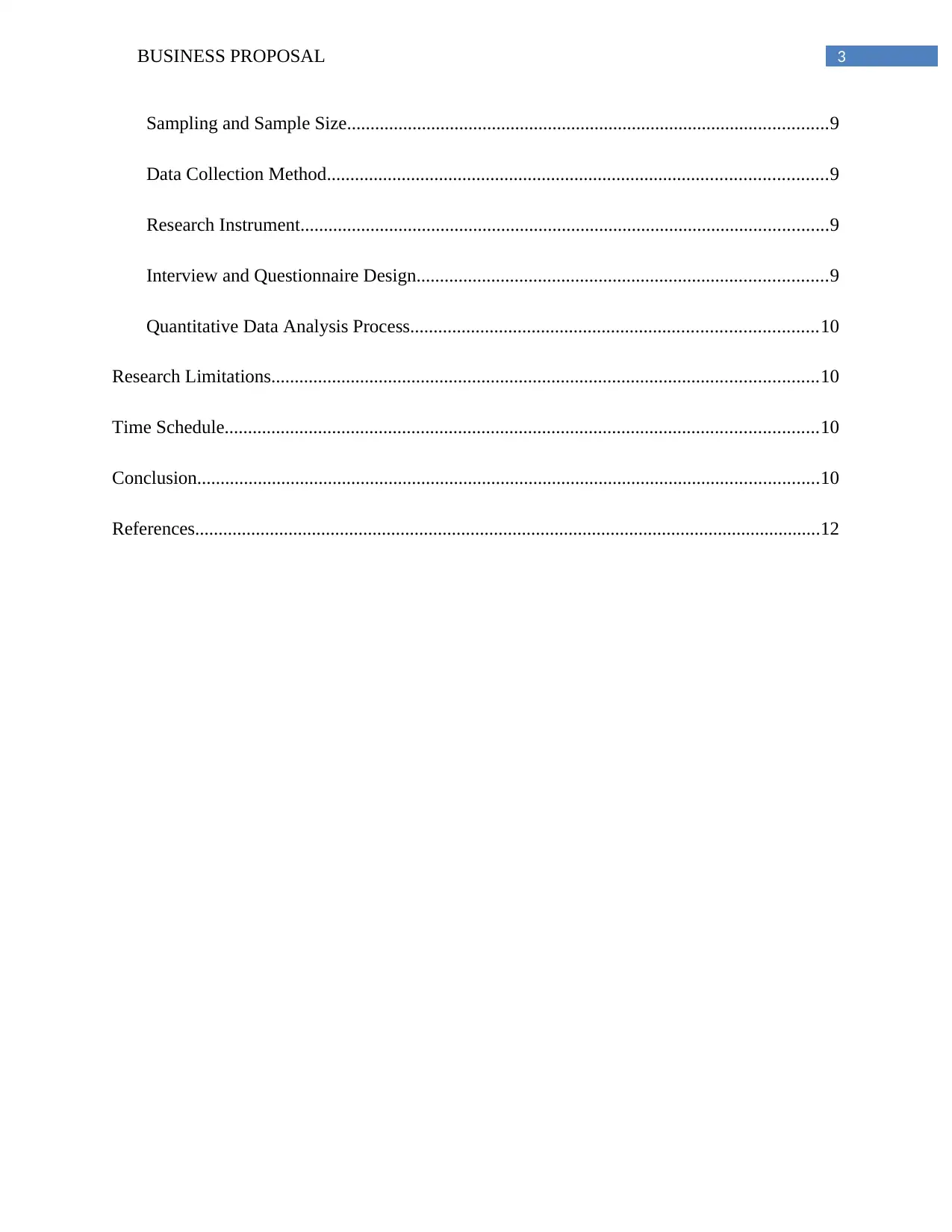
3BUSINESS PROPOSAL
Sampling and Sample Size.......................................................................................................9
Data Collection Method...........................................................................................................9
Research Instrument.................................................................................................................9
Interview and Questionnaire Design........................................................................................9
Quantitative Data Analysis Process.......................................................................................10
Research Limitations.....................................................................................................................10
Time Schedule...............................................................................................................................10
Conclusion.....................................................................................................................................10
References......................................................................................................................................12
Sampling and Sample Size.......................................................................................................9
Data Collection Method...........................................................................................................9
Research Instrument.................................................................................................................9
Interview and Questionnaire Design........................................................................................9
Quantitative Data Analysis Process.......................................................................................10
Research Limitations.....................................................................................................................10
Time Schedule...............................................................................................................................10
Conclusion.....................................................................................................................................10
References......................................................................................................................................12
Paraphrase This Document
Need a fresh take? Get an instant paraphrase of this document with our AI Paraphraser

4BUSINESS PROPOSAL
Introduction
Global team is a combination of workers across the temporal, cultural and geographical
boundaries and brought together in a single framework. Multinational companies use it as a
solution to Human Resource aiming to increase the performance. Integration of employees from
different ethnic background provides innovative ideas and different approaches to any particular
issue. Multiple dimensions of a single issue help in effective targeting of the market. Despite of
the advantages identified, various issues occur in managing a global team. A number of
researches are reviewed in the literature review section to identify and evaluate the challenges
faced by the multinational enterprises in the management. The impact of cultural diversity and
international HRM is also highlighted. A hypothesis is formulated from the study with research
questions to address the gap found in literature. A detailed description of methodologies is
proposed to carry out the research process with limitations and research time schedule.
Project Objective
To identify the challenges faced by the management
To identify the mechanism of virtuality management and cultural diversity management
To identify the advantages and impact of IHRM implication
Project Scope
The scope of the project is good and the project is focused on the challenges faced by the
multinational companies in managing their global team. In spite of having positive impact on the
organization and increase the work efficiency, it demonstrates some major challenges due to the
diverse culture and communication gap. Research can be carried out focusing on these topics.
Introduction
Global team is a combination of workers across the temporal, cultural and geographical
boundaries and brought together in a single framework. Multinational companies use it as a
solution to Human Resource aiming to increase the performance. Integration of employees from
different ethnic background provides innovative ideas and different approaches to any particular
issue. Multiple dimensions of a single issue help in effective targeting of the market. Despite of
the advantages identified, various issues occur in managing a global team. A number of
researches are reviewed in the literature review section to identify and evaluate the challenges
faced by the multinational enterprises in the management. The impact of cultural diversity and
international HRM is also highlighted. A hypothesis is formulated from the study with research
questions to address the gap found in literature. A detailed description of methodologies is
proposed to carry out the research process with limitations and research time schedule.
Project Objective
To identify the challenges faced by the management
To identify the mechanism of virtuality management and cultural diversity management
To identify the advantages and impact of IHRM implication
Project Scope
The scope of the project is good and the project is focused on the challenges faced by the
multinational companies in managing their global team. In spite of having positive impact on the
organization and increase the work efficiency, it demonstrates some major challenges due to the
diverse culture and communication gap. Research can be carried out focusing on these topics.

5BUSINESS PROPOSAL
Literature Review
Definition of Global team
The contribution of the formation of global team goes to globalization. This is a
geographically dispersed virtual workforce that serves as the principle vehicle of business
organizations achieving the global efficiency. Global teams are formed with an idea to resolve
the issues like diversified target audience demand, converging markets, and resource allocation
faced by multinational enterprises. Dixon (2008) defined global team as a dispersed,
multicultural virtual team. Internationalization of business has led the global team to proliferate
best operations and practices in the global market. According to Araujo (2009), sustainability
and growth can be achieved using global team to manage and execute the complex strategic
interventions. Significant management is essential for a global team to address the challenges
faced due to virtual communication and diversified cultural accumulation.
Managing Virtuality and Cultural Diversity in global teams
Addressing the human resource management of a global team is considerably different
and more difficult compared to the traditional teams (Hansen, Hop and Moehler 2012). Various
methods have been proposed by different scholars over time that are put under two broad
selections. They are:
Mechanism for Managing virtuality
Barriers in interaction between the team members due to the virtual communication needs
to be managed in an efficient order to avoid possible issues that might rise between the team
members that has negative impact on its efficiency. Three possible ways of managing the
virtuality is possible to identify from the present literature.
Literature Review
Definition of Global team
The contribution of the formation of global team goes to globalization. This is a
geographically dispersed virtual workforce that serves as the principle vehicle of business
organizations achieving the global efficiency. Global teams are formed with an idea to resolve
the issues like diversified target audience demand, converging markets, and resource allocation
faced by multinational enterprises. Dixon (2008) defined global team as a dispersed,
multicultural virtual team. Internationalization of business has led the global team to proliferate
best operations and practices in the global market. According to Araujo (2009), sustainability
and growth can be achieved using global team to manage and execute the complex strategic
interventions. Significant management is essential for a global team to address the challenges
faced due to virtual communication and diversified cultural accumulation.
Managing Virtuality and Cultural Diversity in global teams
Addressing the human resource management of a global team is considerably different
and more difficult compared to the traditional teams (Hansen, Hop and Moehler 2012). Various
methods have been proposed by different scholars over time that are put under two broad
selections. They are:
Mechanism for Managing virtuality
Barriers in interaction between the team members due to the virtual communication needs
to be managed in an efficient order to avoid possible issues that might rise between the team
members that has negative impact on its efficiency. Three possible ways of managing the
virtuality is possible to identify from the present literature.
⊘ This is a preview!⊘
Do you want full access?
Subscribe today to unlock all pages.

Trusted by 1+ million students worldwide
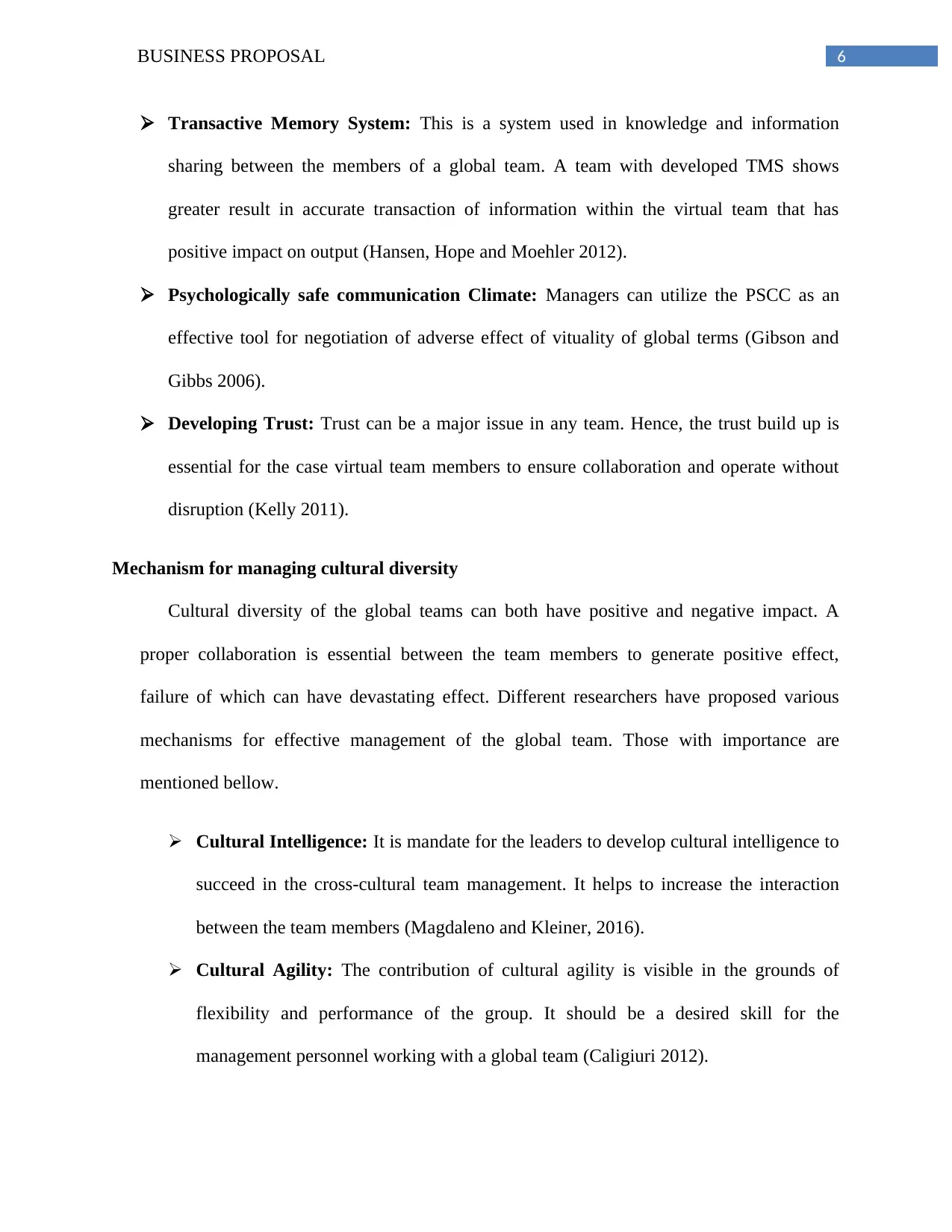
6BUSINESS PROPOSAL
Transactive Memory System: This is a system used in knowledge and information
sharing between the members of a global team. A team with developed TMS shows
greater result in accurate transaction of information within the virtual team that has
positive impact on output (Hansen, Hope and Moehler 2012).
Psychologically safe communication Climate: Managers can utilize the PSCC as an
effective tool for negotiation of adverse effect of vituality of global terms (Gibson and
Gibbs 2006).
Developing Trust: Trust can be a major issue in any team. Hence, the trust build up is
essential for the case virtual team members to ensure collaboration and operate without
disruption (Kelly 2011).
Mechanism for managing cultural diversity
Cultural diversity of the global teams can both have positive and negative impact. A
proper collaboration is essential between the team members to generate positive effect,
failure of which can have devastating effect. Different researchers have proposed various
mechanisms for effective management of the global team. Those with importance are
mentioned bellow.
Cultural Intelligence: It is mandate for the leaders to develop cultural intelligence to
succeed in the cross-cultural team management. It helps to increase the interaction
between the team members (Magdaleno and Kleiner, 2016).
Cultural Agility: The contribution of cultural agility is visible in the grounds of
flexibility and performance of the group. It should be a desired skill for the
management personnel working with a global team (Caligiuri 2012).
Transactive Memory System: This is a system used in knowledge and information
sharing between the members of a global team. A team with developed TMS shows
greater result in accurate transaction of information within the virtual team that has
positive impact on output (Hansen, Hope and Moehler 2012).
Psychologically safe communication Climate: Managers can utilize the PSCC as an
effective tool for negotiation of adverse effect of vituality of global terms (Gibson and
Gibbs 2006).
Developing Trust: Trust can be a major issue in any team. Hence, the trust build up is
essential for the case virtual team members to ensure collaboration and operate without
disruption (Kelly 2011).
Mechanism for managing cultural diversity
Cultural diversity of the global teams can both have positive and negative impact. A
proper collaboration is essential between the team members to generate positive effect,
failure of which can have devastating effect. Different researchers have proposed various
mechanisms for effective management of the global team. Those with importance are
mentioned bellow.
Cultural Intelligence: It is mandate for the leaders to develop cultural intelligence to
succeed in the cross-cultural team management. It helps to increase the interaction
between the team members (Magdaleno and Kleiner, 2016).
Cultural Agility: The contribution of cultural agility is visible in the grounds of
flexibility and performance of the group. It should be a desired skill for the
management personnel working with a global team (Caligiuri 2012).
Paraphrase This Document
Need a fresh take? Get an instant paraphrase of this document with our AI Paraphraser
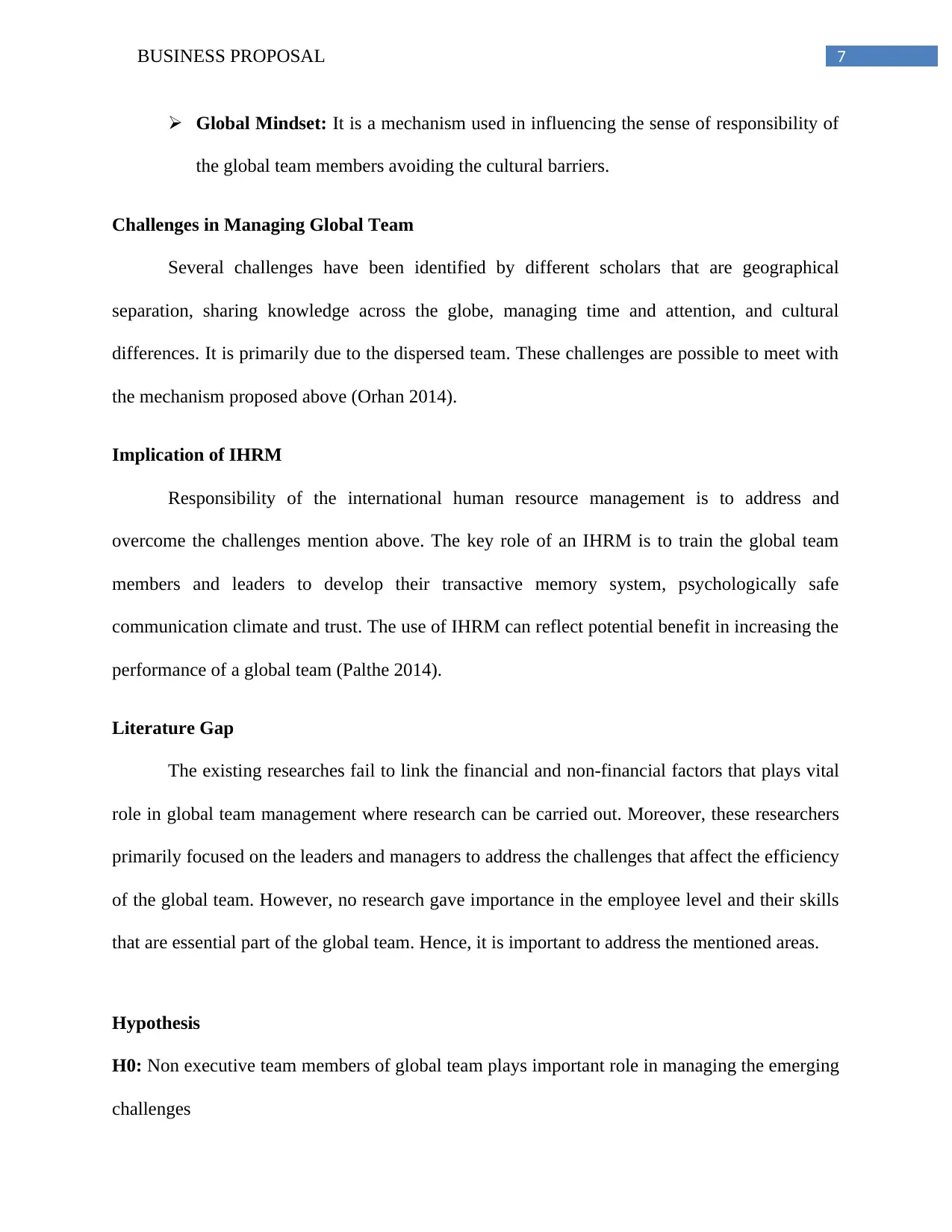
7BUSINESS PROPOSAL
Global Mindset: It is a mechanism used in influencing the sense of responsibility of
the global team members avoiding the cultural barriers.
Challenges in Managing Global Team
Several challenges have been identified by different scholars that are geographical
separation, sharing knowledge across the globe, managing time and attention, and cultural
differences. It is primarily due to the dispersed team. These challenges are possible to meet with
the mechanism proposed above (Orhan 2014).
Implication of IHRM
Responsibility of the international human resource management is to address and
overcome the challenges mention above. The key role of an IHRM is to train the global team
members and leaders to develop their transactive memory system, psychologically safe
communication climate and trust. The use of IHRM can reflect potential benefit in increasing the
performance of a global team (Palthe 2014).
Literature Gap
The existing researches fail to link the financial and non-financial factors that plays vital
role in global team management where research can be carried out. Moreover, these researchers
primarily focused on the leaders and managers to address the challenges that affect the efficiency
of the global team. However, no research gave importance in the employee level and their skills
that are essential part of the global team. Hence, it is important to address the mentioned areas.
Hypothesis
H0: Non executive team members of global team plays important role in managing the emerging
challenges
Global Mindset: It is a mechanism used in influencing the sense of responsibility of
the global team members avoiding the cultural barriers.
Challenges in Managing Global Team
Several challenges have been identified by different scholars that are geographical
separation, sharing knowledge across the globe, managing time and attention, and cultural
differences. It is primarily due to the dispersed team. These challenges are possible to meet with
the mechanism proposed above (Orhan 2014).
Implication of IHRM
Responsibility of the international human resource management is to address and
overcome the challenges mention above. The key role of an IHRM is to train the global team
members and leaders to develop their transactive memory system, psychologically safe
communication climate and trust. The use of IHRM can reflect potential benefit in increasing the
performance of a global team (Palthe 2014).
Literature Gap
The existing researches fail to link the financial and non-financial factors that plays vital
role in global team management where research can be carried out. Moreover, these researchers
primarily focused on the leaders and managers to address the challenges that affect the efficiency
of the global team. However, no research gave importance in the employee level and their skills
that are essential part of the global team. Hence, it is important to address the mentioned areas.
Hypothesis
H0: Non executive team members of global team plays important role in managing the emerging
challenges

8BUSINESS PROPOSAL
H1: Non executive team members of global team plays no as such role in team management and
addressing the challenges
Research Questions
Research questions are compared with the compass of researchers as it guides the
research and drives it to the proper direction preventing it from going off track. There are two
types of research questions that are primary and secondary research questions. Primary questions
searches for the end result. Whereas, the secondary questions are formed in order to obtain the
answer for the primary question.
Primary Question
What is the importance of non executive member of the management that are the team
members of a global team?
Secondary Question
Who are the non executive members of the management in a global team?
What role do they play in the team?
Does their role have any connection with the issues that occurs in a global team?
Is it possible for them to address minimize the negative impact overcome the challenges?
What skills do they require to address the issues faced?
Research Design and Methodology
Research methods and designs are of two type that are mention bellow. It is essential to
select appropriate method for the success of the research.
H1: Non executive team members of global team plays no as such role in team management and
addressing the challenges
Research Questions
Research questions are compared with the compass of researchers as it guides the
research and drives it to the proper direction preventing it from going off track. There are two
types of research questions that are primary and secondary research questions. Primary questions
searches for the end result. Whereas, the secondary questions are formed in order to obtain the
answer for the primary question.
Primary Question
What is the importance of non executive member of the management that are the team
members of a global team?
Secondary Question
Who are the non executive members of the management in a global team?
What role do they play in the team?
Does their role have any connection with the issues that occurs in a global team?
Is it possible for them to address minimize the negative impact overcome the challenges?
What skills do they require to address the issues faced?
Research Design and Methodology
Research methods and designs are of two type that are mention bellow. It is essential to
select appropriate method for the success of the research.
⊘ This is a preview!⊘
Do you want full access?
Subscribe today to unlock all pages.

Trusted by 1+ million students worldwide
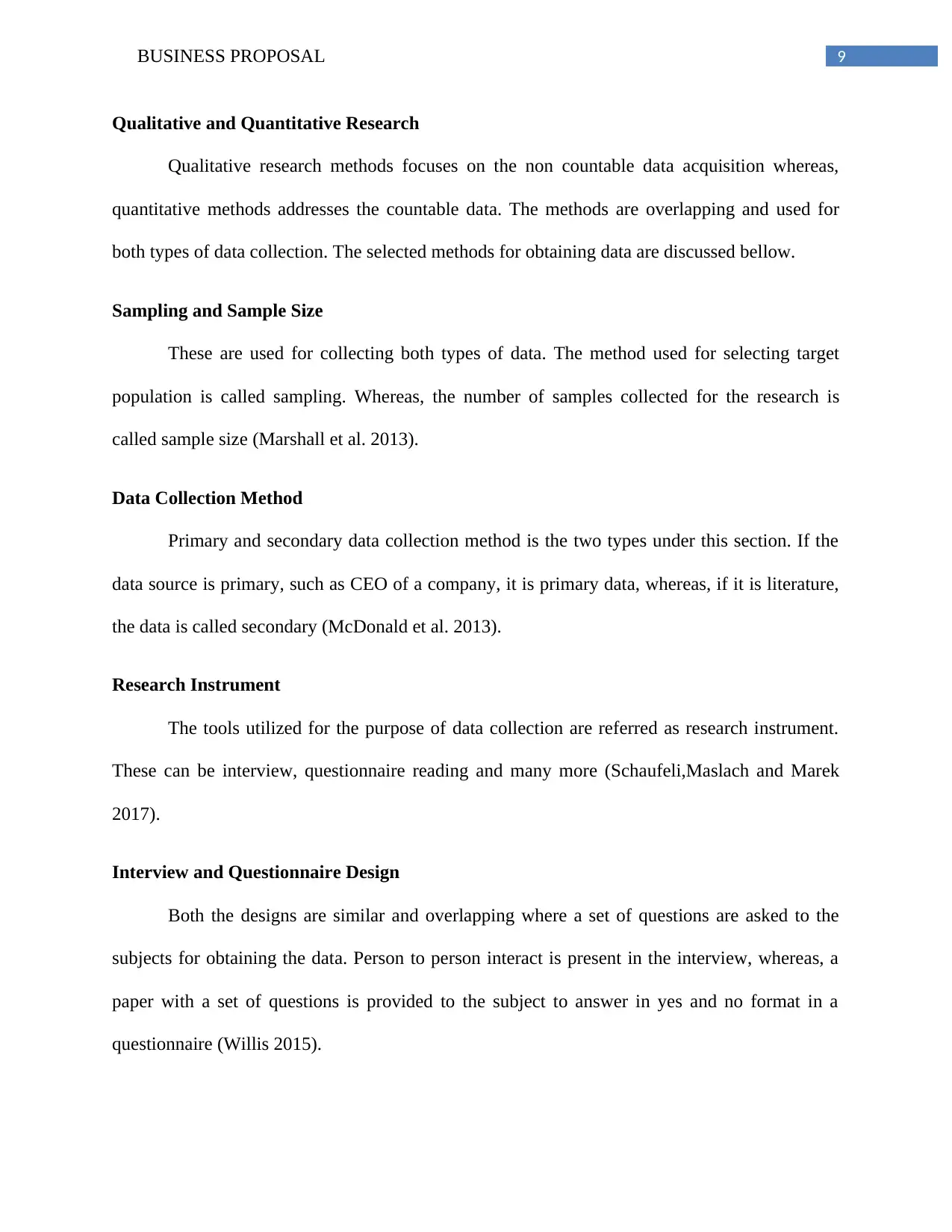
9BUSINESS PROPOSAL
Qualitative and Quantitative Research
Qualitative research methods focuses on the non countable data acquisition whereas,
quantitative methods addresses the countable data. The methods are overlapping and used for
both types of data collection. The selected methods for obtaining data are discussed bellow.
Sampling and Sample Size
These are used for collecting both types of data. The method used for selecting target
population is called sampling. Whereas, the number of samples collected for the research is
called sample size (Marshall et al. 2013).
Data Collection Method
Primary and secondary data collection method is the two types under this section. If the
data source is primary, such as CEO of a company, it is primary data, whereas, if it is literature,
the data is called secondary (McDonald et al. 2013).
Research Instrument
The tools utilized for the purpose of data collection are referred as research instrument.
These can be interview, questionnaire reading and many more (Schaufeli,Maslach and Marek
2017).
Interview and Questionnaire Design
Both the designs are similar and overlapping where a set of questions are asked to the
subjects for obtaining the data. Person to person interact is present in the interview, whereas, a
paper with a set of questions is provided to the subject to answer in yes and no format in a
questionnaire (Willis 2015).
Qualitative and Quantitative Research
Qualitative research methods focuses on the non countable data acquisition whereas,
quantitative methods addresses the countable data. The methods are overlapping and used for
both types of data collection. The selected methods for obtaining data are discussed bellow.
Sampling and Sample Size
These are used for collecting both types of data. The method used for selecting target
population is called sampling. Whereas, the number of samples collected for the research is
called sample size (Marshall et al. 2013).
Data Collection Method
Primary and secondary data collection method is the two types under this section. If the
data source is primary, such as CEO of a company, it is primary data, whereas, if it is literature,
the data is called secondary (McDonald et al. 2013).
Research Instrument
The tools utilized for the purpose of data collection are referred as research instrument.
These can be interview, questionnaire reading and many more (Schaufeli,Maslach and Marek
2017).
Interview and Questionnaire Design
Both the designs are similar and overlapping where a set of questions are asked to the
subjects for obtaining the data. Person to person interact is present in the interview, whereas, a
paper with a set of questions is provided to the subject to answer in yes and no format in a
questionnaire (Willis 2015).
Paraphrase This Document
Need a fresh take? Get an instant paraphrase of this document with our AI Paraphraser

10BUSINESS PROPOSAL
Quantitative Data Analysis Process
There are numerous process of analyzing the collected numeric data that are clearing,
coding, interpretation and presentation. All of these methods of data analysis is summed up as
quantitative data analysis process (Büyüköztürk 2017).
Research Limitations
Every research has a limitation as a research cannot address everything related to the
topic. Time is an important external factor that sets limit for the research. On the other hand,
limitation set by the researcher is important to focus on a particular aspect of the study.
Objectives of the research plays crucial role in setting limits as the research focuses in meeting
the particular objectives (Veld-Merkoulova and Viteva 2016).
Time Schedule
Main activities/ stages Month
Jan
2017
Month
Jun
2017
Month
Dec
2017
Month
Jan
2018
Month
Jun
2018
Month
Dec
2018
Selection of topic
Collecting data from secondary
sources
Constructing the research
layout
Literature review
Development of research Plan
Quantitative Data Analysis Process
There are numerous process of analyzing the collected numeric data that are clearing,
coding, interpretation and presentation. All of these methods of data analysis is summed up as
quantitative data analysis process (Büyüköztürk 2017).
Research Limitations
Every research has a limitation as a research cannot address everything related to the
topic. Time is an important external factor that sets limit for the research. On the other hand,
limitation set by the researcher is important to focus on a particular aspect of the study.
Objectives of the research plays crucial role in setting limits as the research focuses in meeting
the particular objectives (Veld-Merkoulova and Viteva 2016).
Time Schedule
Main activities/ stages Month
Jan
2017
Month
Jun
2017
Month
Dec
2017
Month
Jan
2018
Month
Jun
2018
Month
Dec
2018
Selection of topic
Collecting data from secondary
sources
Constructing the research
layout
Literature review
Development of research Plan
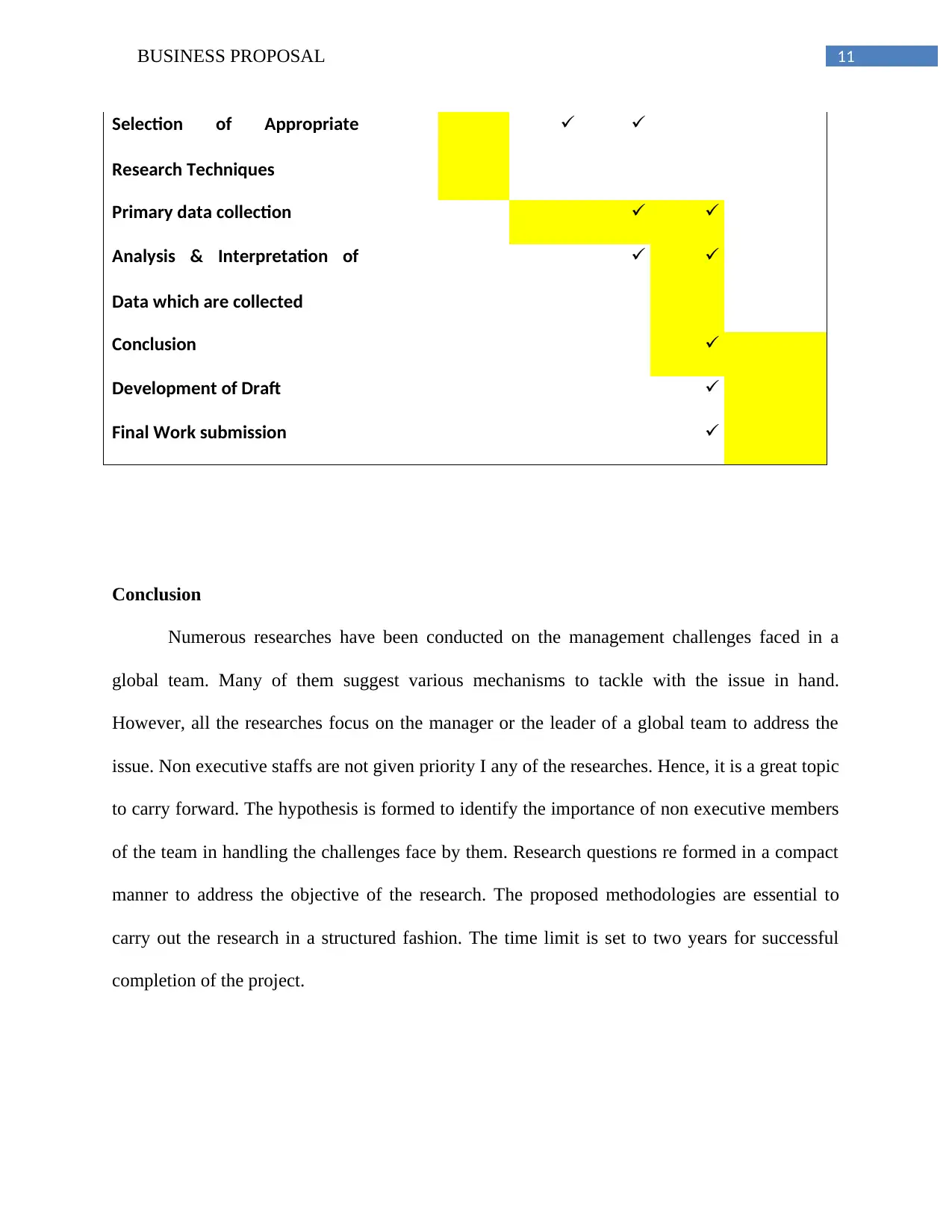
11BUSINESS PROPOSAL
Selection of Appropriate
Research Techniques
Primary data collection
Analysis & Interpretation of
Data which are collected
Conclusion
Development of Draft
Final Work submission
Conclusion
Numerous researches have been conducted on the management challenges faced in a
global team. Many of them suggest various mechanisms to tackle with the issue in hand.
However, all the researches focus on the manager or the leader of a global team to address the
issue. Non executive staffs are not given priority I any of the researches. Hence, it is a great topic
to carry forward. The hypothesis is formed to identify the importance of non executive members
of the team in handling the challenges face by them. Research questions re formed in a compact
manner to address the objective of the research. The proposed methodologies are essential to
carry out the research in a structured fashion. The time limit is set to two years for successful
completion of the project.
Selection of Appropriate
Research Techniques
Primary data collection
Analysis & Interpretation of
Data which are collected
Conclusion
Development of Draft
Final Work submission
Conclusion
Numerous researches have been conducted on the management challenges faced in a
global team. Many of them suggest various mechanisms to tackle with the issue in hand.
However, all the researches focus on the manager or the leader of a global team to address the
issue. Non executive staffs are not given priority I any of the researches. Hence, it is a great topic
to carry forward. The hypothesis is formed to identify the importance of non executive members
of the team in handling the challenges face by them. Research questions re formed in a compact
manner to address the objective of the research. The proposed methodologies are essential to
carry out the research in a structured fashion. The time limit is set to two years for successful
completion of the project.
⊘ This is a preview!⊘
Do you want full access?
Subscribe today to unlock all pages.

Trusted by 1+ million students worldwide
1 out of 14
Related Documents
Your All-in-One AI-Powered Toolkit for Academic Success.
+13062052269
info@desklib.com
Available 24*7 on WhatsApp / Email
![[object Object]](/_next/static/media/star-bottom.7253800d.svg)
Unlock your academic potential
Copyright © 2020–2025 A2Z Services. All Rights Reserved. Developed and managed by ZUCOL.





